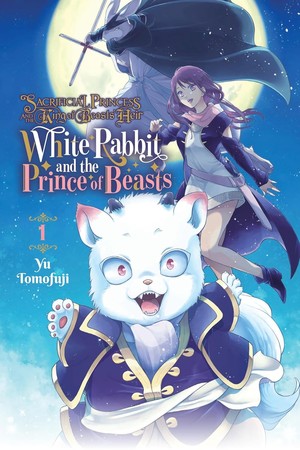The Spring 2025 Manga Guide
Sacrificial Princess and the King of Beasts Heir: White Rabbit and the Prince of Beasts
What's It About?

Sacrificial Princess and the King of Beasts Heir: White Rabbit and the Prince of Beasts has a story and art by Yu Tomofuji, with English translation by Taylor Engel. This volume is lettered by Chris Burgener. Published by Yen Press (March 25, 2025). Rated T.
Is It Worth Reading?
Dee
Rating:

Sacrificial Princess and the King of Beasts Heir: White Rabbit and the Prince of Beasts (henceforth simply Prince of Beasts to save my poor typin' fingers) is a direct sequel to Sacrificial Princess and the King of Beasts, but outside of a few similar themes about class divides and prejudice, it's a very different story. Instead of court intrigue and political drama, this first volume focuses on a road trip adventure about a pampered-but-plucky lad and his two unconventional guardians.
Nine-year-old Richard is a sweet fluffball on a journey to find the true meaning of “strength.” He's written with an endearing balance of childlike shortsightedness, naive ambition, compulsive compassion, and unexpected insight (and his character design is oh-so-huggable). Ravi and Subaru provide a touch of somberness as his somewhat jaded, sympathetically flawed adult mentors. The narrative is slightly episodic, with Richard undertaking a new “training task” each chapter, although it does end on a multi-chapter arc that promises future long-form stories.
Thanks to its young protagonist and road trip structure, Prince of Beasts feels more like a Saturday morning cartoon than a shoujo manga. That's an observation, not a judgment call: I like both genres a lot, and this is an exceedingly charming Saturday morning cartoon, well-drawn and engaging, full of friendship and peril and lessons learned. Plus it's cute as all get-out.
Richard's story works well enough as a standalone that I'd be tempted to throw it at younger readers unfamiliar with the original series. However, the bonus chapters are all prologue and epilogue stories about Sariphi, which get a bit darker than Richard's tale. The author says in the afterword that she assumes her audience has read the original, which also suggests more callbacks in later volumes.
I worry that Prince of Beasts will struggle to find an audience outside the narrow overlap of “read (or watched) the original series” and “enjoy family-friendly adventure tales,” which is unfortunate, because it really is an enjoyable read with some valuable things to say about compassion and self-confidence. But, hey, at least me and the twelve other people in the middle of that venn diagram are going to have a grand old time.
Rebecca Silverman
Rating:

If you wondered what happened to Leonhart and Sariphi after the end of Sacrificial Princess and the King of Beasts, this sequel may not scratch that itch. Creator Yu Tomofuji instead decided to write about their son, Prince Richard, a nine (almost ten!) year old about to face his first major trial as royalty: summoning a holy beast. But like most kids that age, the daunting task is alarming to him, and he decides to run away – and what might have been the usual course for such choices is diverted when a large bird snatches him up and drops him far from home.
Where the original series was a slow-burn fantasy romance with plenty of political intrigue, White Rabbit and the Prince of Beasts is an action adventure, following little Prince Richard (alias Leon) as he travels with white rabbit Ravi and human Subaru on a nebulous quest to “get stronger.” Richard's fear that he won't be able to summon a holy beast stems from a concern that he's not strong enough, although he doesn't appear to fully know what that means, but we can already see that he's got plenty of his parents' best qualities. He's kind and caring, always willing to put himself on the line for someone else. We see it when he helps street child Raku, first joining him to gather junk and then later selling the literal shirt off his back to give him money without making him feel self-conscious. And we see it when he rescues Hairby, a furry fell beast being tormented by dolphins, and then insists on keeping and caring for the monster. Ravi and Subaru have opinions about Richard's actions, but they mostly function as guides and guardians, always stepping back unless Richard needs real help, thereby allowing him to make his own decisions.
What's interesting is that in rescuing Hairby, Richard risks the very thing he's trying to prove: that he's a worthy successor to his father. Early on in the volume, Leonhart mentions that only “weak” royals summon fell beasts, and now here's Richard caring for one. But I think that that simply goes to show how worthy Richard is. He's Sari's son down to the bone, willing to overlook things he's not “supposed” to accept and charging ahead doing what he knows is right. If that doesn't make him a worthy royal, I don't know what does.
Although this may not scratch the itch for those longing to know what happened to Sariphi and Leonhart after the original series (although there are two short stories about them at the end), it's still a very good book. Tomofuji's art is still wonderful and Richard is adorable in just the right way. You definitely need to have read the original or seen the anime adaptation, but if you have, don't hesitate to pick this up.
Disclosure: Kadokawa World Entertainment (KWE), a wholly owned subsidiary of Kadokawa Corporation, is the majority owner of Anime News Network, LLC. Yen Press, BookWalker Global, and J-Novel Club are subsidiaries of KWE.
discuss this in the forum (28 posts) |
this article has been modified since it was originally posted; see change history
back to The Spring 2025 Manga Guide
Seasonal homepage / archives